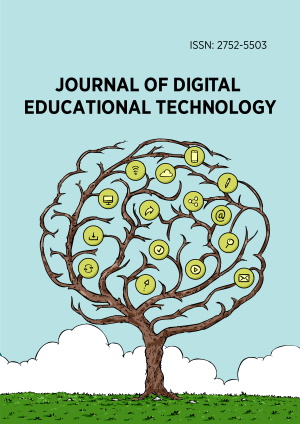Research Article
Awareness and readability of privacy policy documents in mobile loan applications among undergraduate students in Nigeria
More Detail
1 1 Department of Mass Communication, Global Wealth University, Lome, TOGO2 Department of Library and Information Technology, Federal University of Technology, Ikot-Abasi, Akwa Ibom State, NIGERIA3 Department of Sociology, Kogi State University, Anyigba, Kogi State, NIGERIA4 Department of Mass Commnuication, Kogi State University, Anyigba, Kogi State, NIGERIA* Corresponding Author
Journal of Digital Educational Technology, 4(1), January 2024, ep2403, https://doi.org/10.30935/jdet/14107
Submitted: 28 June 2023, Published: 05 January 2024
OPEN ACCESS 2216 Views 1453 Downloads
ABSTRACT
The study investigated the awareness and readability of privacy policy documents on mobile loan applications among undergraduate students at Kogi State University, Anyigba, Kogi State, Nigeria. Two research objectives specifically guided the conduct of the study. The study adopted a descriptive design approach (survey) and the questionnaire as its primary instrument for data collection. The population comprised 33,700 students of Kogi State University. Given the large population, Krejcie and Morgan were used to purposively select 379 undergraduate students who have smartphones across eight faculties. The study’s findings demonstrate adequate knowledge and sensitization on the part of undergraduates to privacy policy documents on mobile loan applications. It was discovered that students of tertiary institutions were aware of the availability of privacy policy documents on mobile loan applications because of their level of social and technological intelligence. Despite students’ level of awareness of privacy policy documents on mobile loan applications, there is, however, a poor level of readability of privacy policy documents. The study concludes that following the known and unknown consequences, students have failed to carefully read the entire privacy policy documents in a mobile loan application. The study, among others, recommends that commercial banks and other financial institutions should educate the students more adequately on the eventual risks and consequences of not reading privacy policy documents on mobile loan applications, and mobile loan application developers should concisely mention the privacy policies and put security measures in place to protect user’s data.
CITATION (APA)
Mbazu, E. C., Oladokun, B. D., Kakwagh, V. V., & Mohammed, J. D. (2024). Awareness and readability of privacy policy documents in mobile loan applications among undergraduate students in Nigeria. Journal of Digital Educational Technology, 4(1), ep2403. https://doi.org/10.30935/jdet/14107
REFERENCES
- Araújo, T., & Casais, B. (2020). Customer acceptance of shopping-assistant chatbots. In A. Rocha, J. Reis, M. Peter, & Z. Bogdanovic (Eds.), Marketing and smart technologies (pp. 278-287). Springer. https://doi.org/10.1007/978-981-15-1564-4_26
- Auwal, S. A., Zarul, F. Z., Manmeet, M. S., & Azham, H. (2020). Readability of websites security privacy policies: A survey on text content and readers. International Journal of Advanced Science and Technology, 29(6s), 1661-1672.
- Bakker, D., Kazantzis, N., Rickwood, D., & Rickard, N. (2016). Mental health smartphone apps: Review and evidence-based recommendations for future developments. JMIR Mental Health, 3(1), e7. https://doi.org/10.2196/mental.4984
- Davenport, J. R. A., & DeLine, R. (2014). The readability of tweets and their geographic correlation with education. arXiv. https://doi.org/10.48550/arXiv.1401.6058
- Davis, F. D. (1989). Perceived usefulness, perceived ease of use, and user acceptance of information technology. MIS Quarterly, 13(3), 319-340. https://doi.org/10.2307/249008
- Dehling, T., Gao, F., Schneider, S., & Sunyaev, A. (2015). Exploring the far side of mobile health: Information security and privacy of mobile health apps on iOS and Android. JMIR Mhealth Uhealth, 3(1), e8. https://doi.org/10.2196/mhealth.3672
- Derguech, W., Zainab, S. S., & d’Aquin, M. (2018). Assessing the readability of policy documents: The case of terms of use of online services. In Proceedings of the 11th International Conference on Theory and Practice of Electronic Governance. ACM. https://doi.org/10.1145/3209415.3209498
- Fowler, L. R., Gillard, C., & Morain, S. R. (2020). Readability and accessibility of terms of service and privacy policies for menstruation-tracking smartphone applications. Health Promotion Practice, 21(5), 679-683. https://doi.org/10.1177/1524839919899924
- Gyasi, W. K., & Bangmarigu, J. M. (2019). Readability, communication and terms of use of software packages. International Journal of Research Studies in Management, 8(1), 75-88. https://doi.org/10.5861/ijrsm.2019.4401
- Jones, N., & Moffitt, M. (2016). Ethical guidelines for mobile app development within health and mental health fields. Professional Psychology: Research and Practice, 47, 155-162. https://doi.org/10.1037/pro0000069
- Meiselwitz, G. (2013). Readability assessment of policies and procedures of social networking sites. In A. A. Ozok, & P. Zaphiris (Eds.), Online communities and social computing (pp. 67-75). Springer. https://doi.org/10.1007/978-3-642-39371-6_8
- Olmstead, K., & Atkinson, M. (2015). Chapter 1: The majority of smartphone owners download apps. Pew Research Center. https://www.pewresearch.org/internet/2015/11/10/the-majority-of-smartphone-owners-download-apps/
- Perrin, A. (2015). Social media usage: 2005-2015. Pew Research Center. https://www.pewinternet.org/2015/10/08/social-networking-usage-2005-2015/
- Robillard, J. M., Feng, T. L., Sporn, A. B., Lai, J.-A., Lo, C., Ta, M., & Nadler, R. (2019). Availability, readability, and content of privacy policies and terms of agreements of mental health apps. Internet Interventions, 17, 100243. https://doi.org/10.1016/j.invent.2019.100243
- Scheufele, D. A., & Krause, N. M. (2019). Science audiences, misinformation, and fake news. Proceedings of the National Academy of Sciences, 116(16), 7662-7669. https://doi.org/10.1073/pnas.1805871115
- Sotiloye, B. S., & Bodunde, H. (2018). Assessment of students’ reading culture in a Nigerian university: Waxing or waning? Legon Journal of the Humanities, 29(2), 285-307. https://doi.org/10.4314/ljh.v29i2.11
- Temnikova, I., Vieweg, S., & Castillo, C. (2015). The case for readability of crises communication in social media. In Proceedings of the 24th International Conference on World Wide Web (pp. 1245-1250). ACM. https://doi.org/10.1145/2740908.2741718
- Waldman, A. E. (2017). A statistical analysis of privacy policy design. Notre Dame Law Review Online, 93(1), 12.
- Wanjiru, P. M., Mutiso, A. N., & Maina, M. (2022). Mobile money and sustainability of registered commercial banks in Kenya. International Journal of Business and Management Review, 10(7), 19-28. https://doi.org/10.37745/ijbmr.2013/vol10n71928
- Zhou, L., Bao, J., Watzlaf, V., & Parmanto, B. (2019). Barriers to and facilitators of the use of mobile health apps from a security perspective: Mixed-methods study. JMIR Mhealth Uhealth, 7(4), e11223. https://doi.org/10.2196/11223

 The articles published in this journal are licensed under the CC-BY Creative Commons Attribution International License.
The articles published in this journal are licensed under the CC-BY Creative Commons Attribution International License.